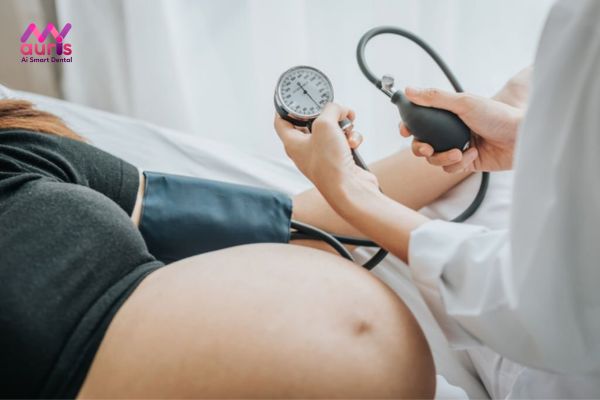During a mother’s pregnancy, everyone will certainly look forward to the day they welcome their baby into the world. Therefore, pregnant mothers need to update their knowledge, carefully learn about the signs of impending labor, and prepare psychologically before giving birth. Let’s refer to this article, My Auris will help you know the signs of labor, as well as provide some notes when the mother sees these phenomena!
Signs of labor about to give birth that mothers need to keep in mind idea
According to concept, after 9 months and 10 days of pregnancy, the mother has reached her due date. However, childbirth is often difficult to follow as planned and children can be born at any time. Therefore, pregnant mothers need to understand the signs of impending labor to mentally prepare for labor, enter the labor stage and welcome the family’s little angel.

Lower abdominal prolapse
In the last days of pregnancy, the fetus will gradually move down to the mother’s pelvic area, well preparing for labor. This phenomenon can happen a few weeks or even just a few hours before the mother gives birth. It is especially easy to accept writing in the case of giving birth to your first child.
However, for mothers giving birth for the second time onwards, the signs of labor will often be quite vague and unclear, only felt when the birth process officially begins. At this time, the baby is in a ready position to be born, the baby’s head has turned down, in a low position.
At this time, the baby’s head will press on the bladder and make the mother urinate more, like the first 3 months of pregnancy. The feeling of heaviness in the lower abdomen increases, so the mother will find it difficult to move.
Uterine contractions

Uterine contractions are the most common sign of impending labor. During pregnancy, uterine contractions sometimes appear but with irregular frequency and do not cause bleedingau for the mother, called Braxton Hicks false labor contractions. It is important for mothers to properly understand and recognize the characteristics of real labor contractions.
True labor contractions often appear in the last months of pregnancy with increasing intensity and frequency. At this time, the pregnant woman will feel that her abdomen is hard and painful and does not decrease even after changing positions.
The frequency of contractions takes place continuously and regularly, every 5 to 10 minutes there will be contractions lasting from 30 to 60 seconds, then they will gradually increase every 2 to 3 minutes. Therefore, it will not be difficult for pregnant mothers to recognize normal contractions or labor contractions.
Rupture of membranes
Rupture of membranes is a sign of transition. extremely accurate. Rupture of amniotic fluid is a phenomenon in which fluid flows slowly or massively under the mother’s vagina. At this time, mothers need to wipe off the fluid with a tissue or soft cotton towel. In case the amniotic fluid has an unusual color or an unpleasant odor, the pregnant mother needs to go to the hospital to see a doctor as soon as possible.
The cervix begins to dilate
During the final weeks of pregnancy, the lower part of the uterus will begin to prepare for childbirth, by stretching and thinning before the mother goes into labor, the usual purpose for the baby to be born. During regular prenatal checkups, the doctor can evaluate and monitor the opening of the uterus through vaginal examination.
However, this speed will be different for each pregnant woman. On average, the cervix must dilate 10cm to be considered favorable for childbirth. Includes 2 stages:
- Early stage: The cervix begins to show signs of opening to about 3cm, progressing slowly over about 6 to 8 hours, with an average of 1cm dilated every 2 hours.
- Stage 2: Cervix dilates 3 to 10cm, progresses quite quickly, takes about 7 hours. On average, every hour it will expand by 1cm or maybe more.
There is mucus in the underwear
When going to the bathroom When giving birth, pregnant mothers who see a lot of yellow or light pink mucus appear in the crotch of their underwear should pay attention. Because this sour discharge is due to the mucous plug in the uterus being shed.
This is one of the signs of impending labor that the mother will encounter. At this time, you need to notify a specialist because there is vaginal discharge, a sign that the cervix has opened and labor is about to begin.
Back pain

Back pain can follow the mother until the end of pregnancy. But when giving birth, these pains will occur more often and may be more intense. Also accompanied by cramps.
This is a sign of labor that mothers need to pay attention to. According to experts, when pregnant mothers prepare to give birth, the joints will stretch in the back and pelvis, creating favorable conditions for the baby in the womb to more easily come out.
The fetus kicks continuously
When preparing to welcome your baby into the world, the baby in your belly will kick continuously. The reason is because the baby is getting bigger and bigger and the area in the uterus is no longer spacious, making the baby’s body feel cramped and can kick the mother continuously to want to get out.
Joint stretch
During pregnancy, the hormone relaxin helps the mother’s ligaments become softer and more relaxed. At this time, the joints can become more flexible, helping the pelvis expand and create favorable conditions for the labor process. In fact, this is a natural reaction so mothers do not need to panic.
What should mothers do when there are signs of labor?

In fact, the due date provided by the doctor is only the estimated date, and in many cases it will not be correct. Therefore, when signs of impending labor appear, the mother needs to stay calm and not worry as well as follow the following:
- First of all, the mother needs to have a prenatal checkup according to her doctor’s appointment to be monitored and know exactly whether it is time to be hospitalized or not. At that time, you will be instructed by the doctor and midwife to prepare the items and documents you need to bring, etc.
- Need to get used to the pain: Labor contractions all cause pain. However, labor contractions are an active and necessary part. Because with each contraction, the time of your baby’s birth is getting closer.
- Control your breathing well, relax your body by breathing slowly and gently. This helps you reduce anxiety and pain.
Hopefully the above information can help you better understand the signs of impending labor. The mother needs to pay attention and be cautious with the above signs, in order to immediately notify the doctor for timely treatment. The important thing is that the mother needs to keep herself in a comfortable state of mind and eat properly so that the birth process can go smoothly. Minimize unwanted complications affecting both mother and child.
Yen Nhi





